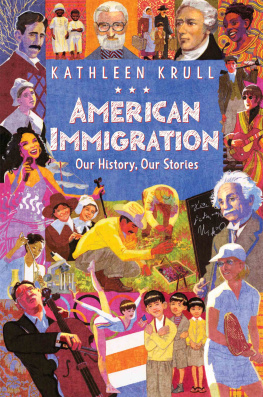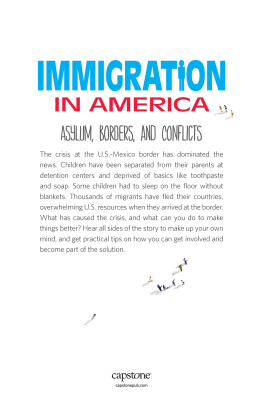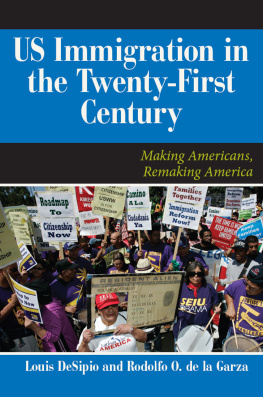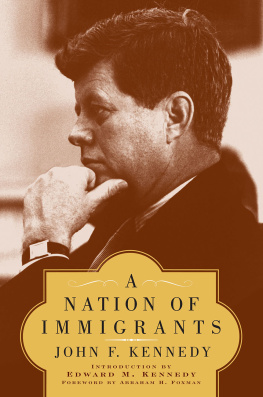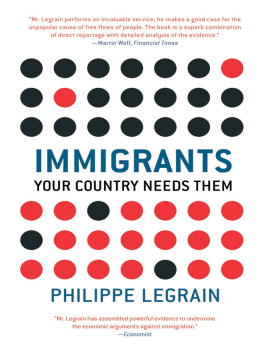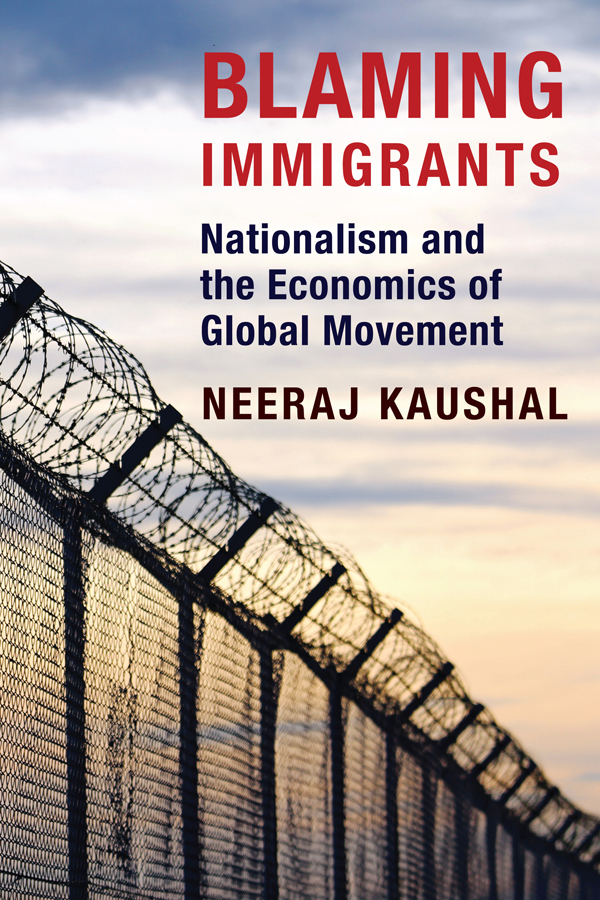Contents
Guide
Pagebreaks of the print version
Blaming Immigrants
Blaming Immigrants
Nationalism and the Economics of Global Movement
NEERAJ KAUSHAL

COLUMBIA UNIVERSITY PRESS
New York
Columbia University Press
Publishers Since 1893
New YorkChichester, West Sussex
cup.columbia.edu
Copyright 2019 Columbia University Press
All rights reserved
E-ISBN 978-0-231-54360-6
Library of Congress Cataloging-in-Publication Data
Names: Kaushal, Neeraj, author.
Title: Blaming immigrants : nationalism and the economics of global movement / Neeraj Kaushal.
Description: New York : Columbia University Press, [2018] | Includes bibliographical references and index.
Identifiers: LCCN 2018026577 | ISBN 9780231181440 (cloth : alk. paper) | ISBN 9780231181457 (pbk. : alk. paper)
Subjects: LCSH: Emigration and immigrationEconomic aspects. | Emigration and immigrationPolitical aspects. | Emigration and immigrationGovernment policy. | Nationalism.
Classification: LCC JV6217 .K38 2018 | DDC 325/.1dc23
LC record available at https://lccn.loc.gov/2018026577
A Columbia University Press E-book.
CUP would be pleased to hear about your reading experience with this e-book at .
Contents
1
Introduction: Its Not a Crisis
2
Causes of Discontent
3
The Costs and Benefits of Restricting Immigration
4
Is Americas Immigration System Broken?
5
From Global to Local: Toward Integration or Exclusion?
6
The Balance Sheet: Economic Costs and Benefits of Immigration
7
Refugees and Discontent
8
Crime, Terrorism, and Immigration
9
Addressing the Discontent
We think of international immigration in grandiose phrases. It is a problem in need of a solution, a crisis crying out for attention, a surge demanding containment. Images of overladen boats, trucks, and trains crammed with immigrants are all over the media, lending credibility to these exaggerations and distorting the reality of immigration. In proportion to world population, the number of global immigrantspeople living outside their country of birthis a modest 3 percent. Not a deluge, not a surge, not a flood, not even a stream, but a trickle.
The increase in immigration globally over the past quarter century is largely in line with the growth in world population. The number of immigrants as a proportion of world population has not budged for over a century. It was 3 percent in 1900. Ninety years later, in 1990, and another quarter century further on, in 2015, it remained 3 percent.
Yet immigration is one of the most divisive issues of our times. It is a source of cheap labor, talent, and entrepreneurial ingenuity. It is also a source of economic, social, and political discontents within native-born populations, arising from fears that immigrants will take the jobs of local workers and bring foreign cultures and identities that threaten the social fabric of host societies, destroy national identities, and expose host countries to international terrorism and crime. In countries across Europe, North America, and Asia, these fears have brought back the acrid odor of the 1920s, to use the words of historian John Higham, threatening the return of an era that severely restricted immigration.
The Global Immigration Scene
From Austria, Britain, Denmark, and France all the way to Malaysia, South Africa, the United Kingdom, and the United States, immigration is shaking electoral politics. In some countries, ultraconservatives are articulating public fears of immigration. In others, they are simply taking advantage of public anxiety to advance their exclusionist agenda. The radical right has won a few elections here and there, but in most countries (e.g., the United Kingdom, Germany, Hungary, and Italy), it is effectively pushing the centrist right parties to turn extreme on immigration, and in some (like Germany and the United Kingdom), it is weakening the resolve of liberal pro-immigration parties to welcome immigrants.
Since 2010 most of Europe has seen the rise of far-right, anti-immigration, ultranationalist political parties. In France, it is the National Front; in Italy, the Lega Nord (Northern League), Forza Italia, and the Five Star Movement; in Austria, the Freedom Party; in Denmark, the Danish Peoples Party; in the Netherlands, the Freedom Party; in Greece, Golden Dawn; in Germany, Alternative for Deutschland; in Hungary, Fidesz Party and Jobbik Party; and in the United Kingdom, the Independence Party.
In 2015 and 2016 the far-right parties in Germany, Denmark, Poland, Slovakia, Hungary, Switzerland, Italy, and Greece made significant gains in state, regional, or national elections. But the pendulum swung back in 2017, when Emmanuel Macron defeated the far-right Marine Le Pen in France and Angela Merkel won her fourth term as German chancellor (even though Alternative for Germany, the anti-immigration party, improved its position and entered the German parliament). In the United Kingdom, the conservatives lost their majority. Elsewhere, the anti-immigration brigade continues to make progress. In Austria, Sebastian Kurz of the Austrian Peoples Party has changed the partys agenda to match that of the far-right Freedom Party. In the 2018 general elections in Italy, two right-wing anti-immigration parties were winners; the Five Star Movement won the most votes and the central-right alliance led by Lega Nord the most seats in the Senate and the Chamber of Deputies. Overall, in the second decade of the twenty-first century, immigration remains a burning political issue in all Europe.
Hostility toward immigrants is not confined to Western democracies. Indias Bharatiya Janata Party has promised to seal the India-Bangladesh border so that not even birds can fly across.
A hundred years ago similar discontent pushed countries in the New World to close their doors to immigration from Europe, Asia, and Africa. Will history repeat itself? The rising popularity of right-wing political parties suggests that the process may have already begun. Many countries have responded to the growing public and political discontent toward immigrants with restrictive immigration policies, stronger enforcement, increased electronic and human cross-border surveillance, and construction of walls and fences.
In 1989, when the Berlin Wall fell, there were sixteen cross-border fences around the world. By 2016 the number had risen to sixty-five.
ImmigrationAn Untapped Dimension of Globalization
The rising discontent hides the fact that immigration is by far the slowest-moving and relatively untapped dimension of globalization. Despite the Great Recession and the growing cacophony of deglobalization, the average annual FDI flow between 2010 and 2017 was double the flow a decade earlier.
At 3 percent of global population, immigration appears unimpressive given that the three primary coststravel expense, time, and postmigration cost of long-distance communications with family and friends back homehave plummeted over the past century. For those with internet access, the cost of long-distance communication is close to zero; travel cost has fallen to less than a tenth, and long-distance travel time to less than a hundredth, and in some cases, a thousandth, of what they were a hundred years ago.
What is impressive is not the volume of immigration but its paucity. This is even more impressive given the existing global economic inequalities and demographic disparities. Some hope that immigration will rise to reduce these disparities. But so far there is little evidence of that happening. Consider Africa and Europe, two continents with dramatically different demographics and economies. Europe is aging and shrinking; Africa is young and growing. Europe is rich; Africa is poor. In 1900 a quarter of the world population lived in Europe and only one-twelfth in Africa. By 2050 the two continents will exchange places on the global demographic map: a quarter of the world population will be in Africa, and less than a fourteenth in Europe. For immigration to make a dent in these proportions, it will have to be many times the current or past levels, which appears unlikely given the public intolerance and political response.



